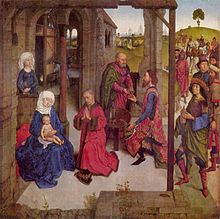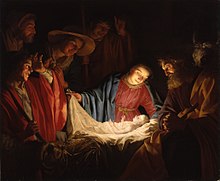
Myrrh is a gum-resin extracted from a few small, thorny tree species of the Commiphora genus, belonging to the Burseraceae family. Myrrh resin has been used throughout history in medicine, perfumery, and incenses. Myrrh mixed with posca or wine was widely used in many ancient cultures to produce pleasurable feelings and as an anti-inflammatory and analgesic.
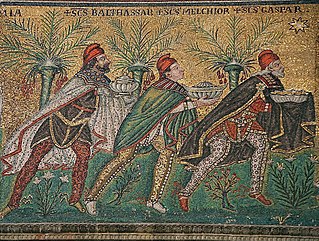
In Christianity, the Biblical Magi, also known as the Three Wise Men, Three Kings, and Three Magi, are distinguished foreigners who visit Jesus after his birth, bearing gifts of gold, frankincense, and myrrh in homage to his birth. As such, the Magi are commemorated on the feast day of Epiphany—sometimes called "Three Kings Day"—and commonly appear in the nativity celebrations of Christmas.

The Adoration of the Magi or Adoration of the Kings or Visitation of the Wise Men is the name traditionally given to the subject in the Nativity of Jesus in art in which the three Magi, represented as kings, especially in the West, having found Jesus by following a star, lay before him gifts of gold, frankincense, and myrrh, and worship him. It is related in the Bible by Matthew 2:11: "On entering the house, they saw the child with Mary his mother; and they knelt down and paid him homage. Then, opening their treasure chests, they offered him gifts of gold, frankincense, and myrrh. And having been warned in a dream not to return to Herod, they left for their own country by another path".
Casper is a family and personal name derived from Aramaic that means "Treasurer". The origins of the name have been traced as far back as the Old Testament and variations of the name have been adopted by a variety of cultures and languages.

"We Three Kings", original title "Three Kings of Orient", also known as "We Three Kings of Orient Are" or "The Quest of the Magi", is a Christmas carol that was written by John Henry Hopkins Jr. in 1857. At the time of composing the carol, Hopkins served as the rector of Christ Episcopal Church in Williamsport, Pennsylvania, and he wrote the carol for a Christmas pageant in New York City. It was the first widely popular Christmas carol written in America.
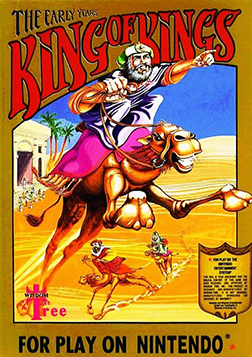
The King of Kings: The Early Years, often shorted to The King of Kings, is an unlicensed Christian Platforming NES game published in 1991 by Wisdom Tree, the creators of Bible Adventures.

Matthew 2:11 is the eleventh verse of the second chapter of the Gospel of Matthew in the New Testament. The magi, dispatched by King Herod, have found the small child Jesus and in this verse present him with gifts in an event known as the Visit of the Wise Men. In art, is traditionally referred to as the Adoration of the Magi.

The Nativity Story is a 2006 American biblical drama film based on the nativity of Jesus and directed by Catherine Hardwicke. The film stars Keisha Castle-Hughes, Oscar Isaac, Hiam Abbass, Shaun Toub, Alexander Siddig, Ciarán Hinds, and Shohreh Aghdashloo.
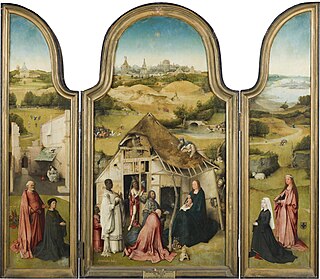
The Adoration of the Magi or The Epiphany is a triptych oil painting on wood panel by the Netherlandish artist Hieronymus Bosch, executed around 1485–1500. It is now in the Museo del Prado in Madrid, Spain.
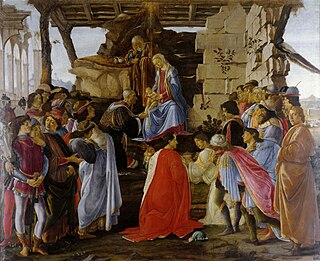
The Adoration of the Magi is a painting by the Italian Renaissance master Sandro Botticelli. Botticelli painted this piece for the altar in Gaspare di Zanobi del Lama's chapel in Santa Maria Novella around 1475. This painting depicts the Biblical story of the Three Magi following a star to find the newborn Jesus. The image of the altarpiece centers on the Virgin Mary and the newborn Jesus, with Saint Joseph behind them. Before them are the three kings who are described in the New Testament story of the Adoration of the Magi. The three kings worship the Christ Child and present him with gifts of gold, frankincense and myrrh. In addition, the Holy Family is surrounded by a group of people who came to see the child who was said to be the son of God.

The Magi Chapel is a chapel in the Palazzo Medici Riccardi of Florence, Italy. Its walls are almost entirely covered by a famous cycle of frescoes by the Renaissance master Benozzo Gozzoli, painted around 1459 for the Medici family, the effective rulers of Florence.
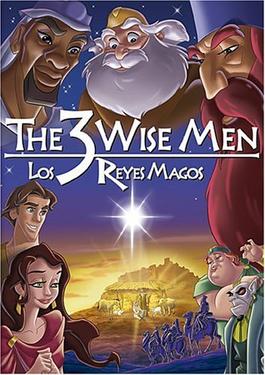
Los Reyes Magos is a 2003 Spanish animated film. It tells the story of the visit of the Magi to the baby Jesus and the wrath of Herod. The film was directed by Antonio Navarro, who was nominated for a Goya Award for this film. The film contains the voice talents of José Coronado, Juan Echanove and Imanol Arias in the original version and the voice acting of father-son actors Martin Sheen and Emilio Estevez in the English dub.

The Adoration of the Kings is an oil-on-panel painting of the Adoration of the Magi by the Netherlandish Renaissance artist Pieter Bruegel the Elder, painted in 1564, and now in the National Gallery, London.
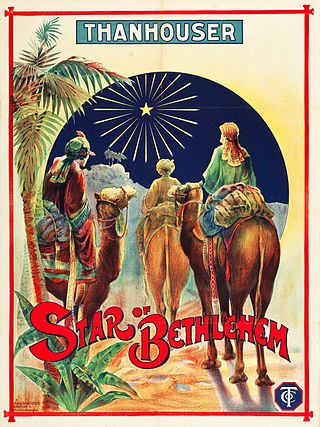
The Star of Bethlehem is a 1912 American silent film produced by Edwin Thanhouser and Charles J. Hite, and featuring Florence La Badie, James Cruze, and William Russell. The film is a retelling of Biblical events preceding the Nativity of Jesus. Directed by Lawrence Marston, the entire film is staged as brief tableaux. With much of the original lost, the existing footage can be difficult to interpret as a coherent whole.
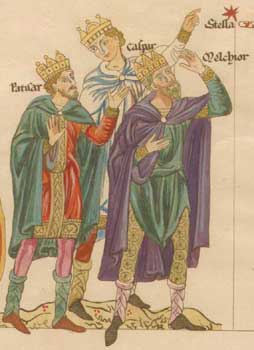
Melchior, or Melichior, was purportedly one of the Biblical Magi who visited the infant Jesus after he was born. Melchior was often referred to as the oldest member of the Magi. He was traditionally called the King of Persia and brought the gift of gold to Jesus. In the Western Christian church, he is regarded as a saint.

Balthazar, also called Balthasar, Balthassar, and Bithisarea, was according to Western Christian tradition one of the three biblical Magi along with Caspar and Melchior who visited the infant Jesus after he was born. Balthazar is traditionally referred to as the King of Arabia and gave the gift of myrrh to Jesus. In the Catholic Church, he is regarded as a saint.

The Adoration of the Magi is a circa 1480–1485 oil on panel painting of the Adoration of the Magi by the Renaissance artist Geertgen tot Sint Jans. It is held in the collection of the Rijksmuseum, in Amsterdam.

The Adoration of the Magi, is a circa 1645 oil on panel painting of the Nativity by the Dutch artist Salomon Koninck in the collection of the Mauritshuis in The Hague.

The Adoration of the Magi is a 1517 triptych by the Early Netherlandish painter Jacob Cornelisz. van Oostsanen in the collection of the Rijksmuseum.


![Johannes Schoner on Gaspar magus, or Saint Caspar: "The region of Egrisilla, in which there are Brahman [i.e. Indian] Christians; there Gaspar the Magus held dominion," Luculentissima quaedam terrae totius descriptio. Gaspar magus.tif](http://upload.wikimedia.org/wikipedia/commons/thumb/a/ab/Gaspar_magus.tif/lossless-page1-220px-Gaspar_magus.tif.png)
